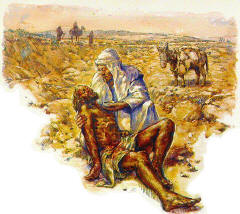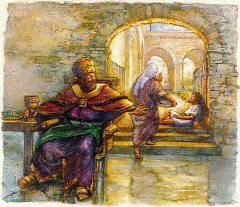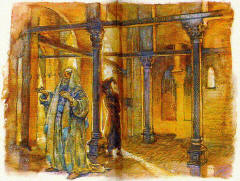The Gospels: What Jesus’ Parables Reveal
About one third of Jesus Christ’s recorded teachings are in the form of parables. What do they mean?
 |
| Only the good Samaritan stopped to help a man of a different race and religion who was beaten and robbed (Luke 10:30-37). Illustrations by Jody Eastman |
The good Samaritan. The pearl of great price. Counting the cost. The good shepherd. New wine in old wineskins. The prodigal son. Sheep and goats. Who hasn’t heard of at least a couple of these? Jesus’ New Testament parables are among the most powerful ideas in Western civilization!
These lessons are at the core of Christ’s teaching. Nearly 2,000 years after Jesus gave them, his parables still sparkle with simple yet sublime insights about life—and startling yet comforting revelations about God’s kingdom. But what, exactly, are parables? And what did Jesus intend that we learn from his parables?
Understand the genre
First, let’s understand that the Bible consists of different types of writing. As we read and study the Bible, we should recognize each type of genre, or in other words, literary style. You wouldn’t read a recipe for lasagna as you would a suicide note. A court summons is no comic strip. Subway graffiti does not a thank-you card make. A love letter is not an encyclopedia article. They are different types of writing, produced by different authors for different audiences. They also invite different responses.
Were parables used to hide the truth?Mark 4:10-12 is one of the most difficult passages in the New Testament. These verses, with parallels in Matthew 13:10-15 and Luke 8:9-10, indicate that Jesus wanted to hide truth as well as reveal it. Mark 4 opens, “He taught them [a crowd] many things by parables” (verse 2). The chapter then relates the parable of the sower (verses 3-8). Jesus’ disciples didn’t get the point. “When he was alone, the Twelve and the others around him asked him about the parables. He told them, ‘The secret of the kingdom of God has been given to you. But to those on the outside everything is said in parables so that, “they may be ever seeing but never perceiving, and ever hearing but never understanding; otherwise they might turn and be forgiven”‘” (verses 10-12). Here Jesus quoted Isaiah 6:9-10. Is the kingdom of God a secret, given only to a chosen few? Did Jesus tell his parables, which seem so simple, so accessible and so timeless, to keep outsiders from understanding the truth? Does God not want to forgive sinners? No one can come to Christ unless first drawn by God the Father (John 6:44). Yet God does not want “anyone to perish, but everyone to come to repentance” (2 Peter 3:9). In fact, God “commands all people everywhere to repent” (Acts 17:30). The explanation of the parable has in fact been published in the Bible, so that everyone can read it. Jesus directed the story of the sower to each listener “who has ears to hear” (Mark 4:9). Jesus’ message demands that we respond. “This is the one I esteem,” God says, “he who is humble and contrite in spirit, and trembles at my word” (Isaiah 66:2). But not everyone approaches the truth of God in the same manner. Jesus intended that people understand the parable of the sower. After all, he went right on to explain it (Mark 4:14-20). Different people respond differently when confronted with the truth. Some of the sown seed (representing the Word of God) is eaten by birds (snatched away by Satan). Some falls on shallow soil and fails to survive in the hot sun (hearers not rooted in the truth). Some is choked by thorns (cares of this life). But some of the seed falls on good soil and produces a crop (hearers who accept God’s truth and produces spiritual fruit). The International Standard Bible Encyclopedia says: “Jesus’ teaching confronted people with radical demands, and not all were willing to comply. Some followed Him in discipleship, but others were actually driven further from the Kingdom…. It is not intellectual but volitional blindness and deafness that is in view” (vol. 3, page 657). Jesus’ listeners saw salvation personified in Jesus, the Son of God. They heard the most important message ever preached. Yet most didn’t understand—they failed to believe and become converted! Matthew 13 includes this episode at the point when Jesus began to concentrate on private teaching of his disciples, rather than public preaching. John 12:40 quotes Isaiah 6:10 at this same point. Jesus’ message was not well received by hard-hearted people. What kind of heart do you have to hear the Savior of the world? |
Many types of writing make up the Bible. Parables, or parabolic passages, concentrated in the Gospels, are one of those genres. The Bible also contains legal codes, such as those you can read in the books of Moses. You will find poetry in the psalms and elsewhere. There are also prophecies, histories, hymns, letters and speeches in the Bible. There are allegories, metaphors, similes, epics, riddles and wise sayings. Bible students call yet other sections didactic, apocalyptic and eschatological. They are all inspired by God. They are “God-breathed” and “useful for teaching, rebuking, correcting and training in righteousness, so that those who belong to God may be thoroughly equipped for every good work” (2 Timothy 3:16-17).
But we need to see these different literary genres—parables included—for what they are, in their contexts. We need to learn as much as we can about who wrote them, and why, and to whom. Legal codes and delicate poetry are different. Sweeping epics are not science texts. Letters may whisper personal details about their writers even as they defy being used to nail down historical or prophetic dates. Metaphors aren’t meant literally. Failure to understand the literary style can lead to misunderstanding and misinterpretation. How, then, should we look at Jesus’ parables?
The background to Jesus’ parables
Jesus’ parables have been called “heavenly stories with earthly meanings,” or “earthly stories with heavenly meanings.” But there is more to them than that. Both the Hebrew word masal and the Greek parabole are broadly used of proverbs, allegories, riddles, illustrations and stories. They can refer to any striking speech formulated to stimulate thought.
Interpreter C.H. Dodd, in his 1935 classic Parables of the Kingdom, defined a parable as “a metaphor or simile drawn from nature or common life, arresting the hearer by its vividness or strangeness, and leaving the mind in sufficient doubt about its precise application to tease it into active thought” (page 16). The International Standard Bible Encyclopedia states that parables are “almost always formulated to reveal and illustrate the kingdom of God” (vol. 3, page 656).
Parables are present, but not common, in the Old Testament. Perhaps the parable that most closely resembles Jesus’ parables is Nathan’s story of the pet lamb, which moved King David to repent (2 Samuel 12:1-13). Judges 9:8-15 and 2 Kings 14:9 symbolize kings and nations as talking plants and a wild beast; these passages are more like fables.
Was Jesus thinking of Ezekiel 17:22-24 when he told the parable of the mustard seed (Mark 4:30-32 and parallel passages)? His parable of the wicked tenants (Mark 12:1-9) echoes Isaiah 5:1-7 (the song of the vineyard). Jesus’ parables often referred to nature to picture the spectacular growth of God’s kingdom from a small beginning.
Outside the Gospels, the Greek parabole appears in the New Testament only in Hebrews 9:9, where the New King James Version says the tabernacle (verse 8) and sacrifices were “symbolic” for the present time, and in Hebrews 11:19, which says that Abraham, “figuratively speaking,’’ received Isaac back from death after proving he was willing to sacrifice his son.
 |
| Jesus described the kingdom of heaven “like treasure hidden in a field” or “like a merchant looking for fine pearls” (Matthew 13:44-45). |
Jesus’ teaching was unique
Early rabbis included parables in their writings. These parables began or ended with, and explained, Old Testament texts. Jesus’ use of parables differed markedly. “The NT parables,” notes The International Standard Bible Encyclopedia, “almost never function in this way [to explain Old Testament passages]: Jesus came not to exegete Scripture, but to reveal the new age of God’s kingdom” (ibid.).
Thus, as we saw above, Jesus Christ’s “nature parables” (for example, the mustard seed) showed how God’s kingdom would start small but become all-encompassing. The kingdom’s present aspects would seem unspectacular, its ultimate realization amazing.
His “discovery parables” (the hidden treasure, Matthew 13:44; or the pearl of great price, verses 45-46) show that God’s kingdom is so valuable we can happily abandon all else for it. His “contrast parables’’ (the rich man and Lazarus, Luke 16:19-31; or the Pharisee and the tax collector, Luke 18:9-14) illuminate how much God loves even the lost and dispossessed and welcomes them into fellowship with him.
The “a fortiori parables”—those that ask “How much more…” (the friend at midnight, Luke 11:5-8; or the persistent widow, Luke 18:1-8)—show how much God can be trusted to act righteously. If even humans won’t act in certain evil ways, Jesus asked, “How much more will your Father in heaven give…?” (Luke 11:13).
“The parables focus on God and his kingdom and in doing so reveal what kind of God he is, by what principles he works, and what he expects of humanity,” comments the Baker Encyclopedia of the Bible (vol. 2, page 1609).
Jesus’ use of parables was so masterful, and the kingdom-centered message of his parables so revolutionary, that no other New Testament personality tried to copy this aspect of his teaching. The uniqueness of Jesus’ parables bolsters their place at the core of our Savior’s message for humanity.
Even critics as extreme as those who make up the Jesus Seminar, who discard much of the Gospels as fabrications by early Christians, believe that in the simple, moving and transcendently beautiful messages of the parables we come as close to the historical Jesus as we are likely to get.
 |
| Jesus contrasted the beggar lying at the gate with the rich man who lived in luxury, to make a spiritual point (Luke 16:19-31). |
Hearing Jesus’ message
Jesus was a master storyteller. His parables contain striking images, dramatic action and bold character development, all built around universal themes that have touched people for two millennia. Yet the parables offer minimal detail. Often Jesus provided no clear explanations for the stories, leaving them open to multiple interpretations through the ages. So how can we know what the parables of Jesus mean? Some interpreters make the mistake of reading more into some parables than Jesus ever intended. In the other ditch are those who fail to catch what some parables clearly emphasize.
Until this century, most interpreters allegorized the parables. This means they looked for symbolic significance in as many details in the stories as possible. Augustine (A.D. 354-430), an early church father, explained the parable of the good Samaritan (Luke 10:30-37) in this way:
The man going down from Jerusalem pictured Adam leaving the peaceful place that was Eden. The robbers who beat him were the devil and his demons, who persuaded Adam to sin. The priest and the Levite (the Law and the Prophets) offered the victim no help, but the Samaritan (Christ) rescued him, pouring oil and wine (comfort and exhortation) onto the man’s wounds. The donkey on which the Samaritan, or Christ, placed the man symbolized the church: the apostle Paul was the innkeeper. This is going too far, reading into the parable far more detail than Jesus intended (Paul was not even a Christian yet!)
| ||||||||||||||||||||||||||||||||||||||||
 |
| To some “who were confident of their own righteousness,” Jesus told the parable of the Pharisee and the tax collector (Luke 18:9). |
By contrast, many modern interpreters have abandoned the allegorical approach. They try to reject the temptation to read their own ideas into the parables, which they believe has led to centuries of abuse of Jesus’ message. These interpreters believe that each parable has only one main point. Others argue that a parable might make up to three main points, one for each of the main characters in the story.
This was the case, they point out, with parables in classical Greek literature, and this is how Jesus’ listeners, in the culture of his day, would have looked at his parables. This view sees the parable of the good Samaritan simply as an exhortation to imitate the Samaritan’s outgoing concern for his neighbor. This interpretation seems consistent with the explanation Jesus himself gave for this parable (verse 37).
The story of the rich man and Lazarus (Luke 16:19-31) is another example. It’s hard to wrench from this parable exact details about the afterlife. Jesus was drawing on images from Jewish and Egyptian folklore, which his listeners would have realized, to show the gulf between arrogant people in this world and those who by humble submission to God come to be in the kingdom of God.
Many modern Bible students try not to over-interpret the parables. Nevertheless, they believe Jesus gave some details not just to add spice to his stories, but to make important points.
“Parables” in JohnThe Gospel of John does not contain the word parable. But John 10:6, following verses 1-5, Jesus’ metaphor of the Good Shepherd, and John 16:25, 29, following verses 20-24, about the woman in travail, translate as “figure” the Greek paroimia, meaning “wise saying” or “riddle.” More than once, the Greek translation of the Old Testament uses paroimia for the Hebrew masal. The Good Shepherd and the woman in travail are similar to the shorter parables in Matthew, Mark and Luke. A.M. Hunter, author of According to John, identifies the following “parables” in the book of John:
None of these “parables” takes the same form as the longer parables in Matthew, Mark and Luke. Yet Jesus’ unique style of teaching is still apparent. Thus these “parables” help establish the historical continuity between the fourth Gospel and the Synoptic Gospels. |
Let the parables speak to you
If we want to understand God’s Word, we need to let the parables speak to our day with vigor and importance. “Parables require their hearers to pass judgment on the events of the story and having done so to realize that they must make a similar judgment in their own lives,” states the Baker Encyclopedia of the Bible (vol. 2, page 1609).
How can you judge your own life by hearing the messages of Jesus’ parables? Study each parable thoroughly, laying aside any preconceived idea of what you think it says—or that you would like it to say. Look at the context in which you find the parable. Doing so may offer clues about its meaning. (But understand that the Gospels often record Jesus’ parables without telling exactly when he gave them, or to whom, or why.)
 |
| Jesus used the illustration of a good shepherd who risked his life for his sheep (John 10:11). |
Take note of the “rule of end stress.” The climax—and point—of most parables comes at the end. Look for principles that reveal what God is like, what his kingdom is all about, how he wants to relate to humanity—and how he expects us to respond to him.
What does the parable tell you about your relationship with God and Christ? The answers you find to this question are the most important points of truth in the Bible, for, as Jesus said. “This is eternal life: that they may know you, the only true God, and Jesus Christ, whom you have sent” (John 17:3).
How does God want a citizen of his kingdom to behave? All of Jesus’ parables contain parts of the answer to this question, for the present and future realities of the kingdom of God are what Christ’s life, work, message, death, resurrection and High Priesthood are all about.
What is your attitude toward that kingdom? “Again,” Jesus said in a parable, “the kingdom of heaven is like a merchant looking for fine pearls. When he found one of great value, he went away and sold everything he had and bought it” (Matthew 13:45-46).
Author: Norman Shoaf
